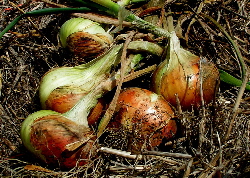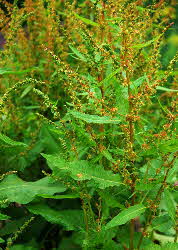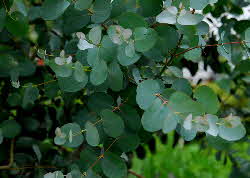|
Other Yellow dye-producing plants include;
1. Onion
2. Dock
3. Eucalyptus
4. Osage Orange

Onion (Allium cepa)
Save your onion skins in a paper bag or in a shoe box. Onion skins kept in plastic bags or glass jars become smelly very quickly. If you do not get enough onion skins from your own cooking, try to get some from the bottom of green grocers trays.
When you have enough skins, bring some water to the boil, throw in the skins and turn the heat off. When the colour of the dye bath is dark enough, strain out the skins and add your fibre. Do not boil the onion skins or you might lose the lovely yellow and get a brownish colour. Different types of onions give different yellows and red onion skins give a more bronze colour.

Dock (Rumex spp)
Dock is of the same genus as sorrel and the same family as rhubarb. It is generally regarded as a wayside weed and grows to about a metre tall. The broad leaves of one species were used in the past to wrap butter for the market and Dock alleviates the sting of nettles if used soon enough.
Dock has a long tap root. To dye with the roots, first dig up a few mature plants. Wash the roots well and cut them up in small pieces using secateurs. Boil the roots for an hour or two in a well ventilated space, as the roots produce a very strong smell. Dock produces a dark olive-yellow colour on silk. In my experience, the roots also stiffened the fabric somewhat.
Eucalyptus / Blue Gum (Eucalyptus spp)
Several different species of eucalyptus can give wonderful orange colours.

Apparently the trees need to be fully grown, and the leaves must be collected at the hottest time of the year, otherwise you may only get an uninspiring beige. The leaves also need to be boiled for two to three hours in a well-ventilated area, as they give off a pleasant but overpowering smell.
More Yellow Dyes
Include Osage Orange, Tea leaves and Yarrow:-
Osage Orange (Maclura pomifera)
The heart wood produces a yellow dye. This tree is also used as a hedge plant. The leaves can be fed to silkworms. The wood was used for making Victorian longbows.
back to Weld, Rhubarb and
Other Traditional Yellow Dyes
Dyers’ Chamomile, Dyers’ Greenweed, Saw-wort, Tansy
Top of page
|